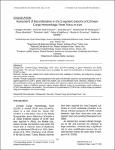Assessment of Recombination in the S-segment Genome of Crimean-Congo Hemorrhagic Fever Virus in Iran
Chinikar, Sadegh
Shah-Hosseini, Nariman
Bouzari, Saeid
Shokrgozar, Mohammad Ali
Mostafavi, Ehsan
Jalali, Tahmineh
Khakifirouz, Sahar
Groschup, Martin H.
Niedrig, Matthias
Background: Crimean-Congo Hemorrhagic Fever Virus (CCHFV) belongs to genus Nairovirus and family Bunyaviridae. The main aim of this study was to investigate the extent of recombination in S-segment genome of CCHFV in Iran. Methods: Samples were isolated from Iranian patients and those available in GenBank, and analyzed by phylogenetic and bootscan methods. Results: Through comparison of the phylogenetic trees based on full length sequences and partial fragments in the S-segment genome of CCHFV, genetic switch was evident, due to recombination event. Moreover, evidence of multiple recombination events was detected in query isolates when bootscan analysis was used by SimPlot software. Conclusion: Switch of different genomic regions between different strains by recombination could contribute to CCHFV diversification and evolution. The occurrence of recombination in CCHFV has a critical impact on epidemiological investigations and vaccine design.
Dateien zu dieser Publikation
Keine Lizenzangabe

